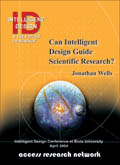
Access
Research
Network
|
|
Access |
ARN-Announce is the on-line announcement and information service of Access Research Network. ARN generates announcements to the current ARN Announce list as information becomes available. You have received this message because your email address was submitted to this list. Subscription and Unsubscription information is at the end of this message.
Click here for a text-only version of this document.
IN THIS ARN-ANNOUNCE:
New 13 video DVD lecture set from the Biola Conference available from ARN
Save 30% when you buy the entire set, or 20% for a set of 5.
 In April 2004 over 30 scientists and educators addressed a conference crowd of over 500 at Biola University on the topic of Intelligent Design and the Future of Science. If there is mounting evidence for intelligent design in nature, then how will this impact how we do science? The list of speakers included Phillip Johnson, William Dembski, Jonathan Wells, Michael Behe, Michael Ruse, William Provine, Marcus Ross, Stephen Meyer, Jed Macosko, John Bloom, J.P. Moreland, Paul Nelson, Robin Collins, Jay Richards, Guillermo Gonzales, Walter Bradley, Hugh Ross, Fuz Rana, Nancy Pearcey, Richard Weikart, John-Mark Reynolds, Lee Strobel, John Calvert, Craig Hazen, Seth Cooper and many more.
In April 2004 over 30 scientists and educators addressed a conference crowd of over 500 at Biola University on the topic of Intelligent Design and the Future of Science. If there is mounting evidence for intelligent design in nature, then how will this impact how we do science? The list of speakers included Phillip Johnson, William Dembski, Jonathan Wells, Michael Behe, Michael Ruse, William Provine, Marcus Ross, Stephen Meyer, Jed Macosko, John Bloom, J.P. Moreland, Paul Nelson, Robin Collins, Jay Richards, Guillermo Gonzales, Walter Bradley, Hugh Ross, Fuz Rana, Nancy Pearcey, Richard Weikart, John-Mark Reynolds, Lee Strobel, John Calvert, Craig Hazen, Seth Cooper and many more.
Although we were not able to capture all of the parallel session lectures on video, we gathered a majority of the significant talks on this 13 DVD set. We are also offering a 5 DVD subset for those who want to view some of the highlights in a smaller dose. All of the DVDs can be ordered individually if there is a particular topic that is of interest.
Although each lecture is packed full of valuable information and worth your time, I have two personal favorites in the bunch: 1) Can Intelligent Design Guide Scientific Research? Lecture by Jonathan Wells and 2) The Cambrian Explosion, lecture by Marcus Ross and Stephen Meyer.
Wells asserts that if Intelligent Design is to be taken seriously in the scientific community, it must be able to solve real-world problems. In order to solve real problems, ID must be able to guide fruitful research. As a first step in that direction, Wells outlines the Theory of Organismal Problem Solving (TOPS) in this lecture. The basics tenets of TOPS include:
Wells points out that Intelligent Design encourages a top-down cellular or organismal perspective rather than a Darwinian bottom-up molecular reductionist perspective. He feels ID can lead to fruitful new research. In closing he summarizes the research he is currently pursuing for cellular causes of cancer based on the ID paradigm.
My other favorite is The Cambrian Explosion lecture by Ross and Meyer. In my opinion this lecture is the best material available to help the non-specialist understand the significance of the Cambrian Explosion, and the graphics in the presentation make a stunning impact. We are also offering this video as a study kit and bundling it with the recent Darwin, Design and Democracy book, which includes a paper by Ross and Meyer that is the basis of the lecture.
So whether you order, one, five (save 20%) or all thirteen DVDs (save 30%), I think you will be impressed with the presentations and update on the latest developments in the ID movement.
To order any or all of the Biola Conference DVD lectures go to: http://www.arn.org/arnproducts/coverimages/v053.htm
 Well, we decided to join the 21st century and start blogging at ARN. For those who have had their head in the sand for the past couple years, a blog (short for weblog) is diary-type tool for websites that makes it easy to post entries or data on the internet. No more HTML coding, just compose and post away.
Well, we decided to join the 21st century and start blogging at ARN. For those who have had their head in the sand for the past couple years, a blog (short for weblog) is diary-type tool for websites that makes it easy to post entries or data on the internet. No more HTML coding, just compose and post away.
Blogs are now proliferating faster than mushrooms in a damp basement. One downside of blogs is that everyone and his brother can now post to the internet, which means everybody and his brother does! So trying to sort through the chaff to find the wheat becomes a time consuming endeavor. But don’t worry, we are not going to convert to stream-of–consciousness posting, just because its there. Instead we are using the technology to consolidate some of our regular columns in to one convenient location. We have created one master blog called The ID Update. This consists of four sub-blogs, one for The ID Wedge Report (formerly the Wedge Update), one for the In The News column, one for an ID Related Links page, and one for a related Literature page. We are now feeding the headlines from these blogs to the ARN home page (see sample above), so you can click on the master block link, the subblog links, or the individual story links. Mark Hartwig has returned to writing ID Wedge Reports for us and you can view just the articles by Mark in the blog here.
Another feature of this technology is the use of an RSS feeder to have these headlines sent to your website, computer, or PDA. No more checking the website to see if something new has been posted. Instead it is delivered to your doorstep. If you run your own website, you can help promote ARN and ID by feeding our headlines to your website (called syndication in RSS lingo). You can go here to learn more about how to speed-read the net using RSS. I’m using the free SharpReader product to have the ID Update news delivered to my laptop along with news from several major newspapers. When I get the time I plan to experiment with RSS feeds to my Treo 600 PDA phone.
In addition to the ID Update blog, we have also added an ARN Quote Library blog. With the blog tools you can do word or author searches, or search by category to find a quote you are interested in. We’ve populated the Quote blog with few quotes to get it started and plan to add many more in the coming months.
If you are confused by all this new blog stuff, just ignore everything I’ve just said and hunt around on our home page until you find something that interests you and click on the link. In that sense, nothing has changed. But, the blog technology makes it easier for our staff to add new material to the website while also providing you more ways to find the information you are interested in. Happy blogging.
This month we are releasing the 3rd printing of David Snoke’s physics textbook, as well as a solution guide that provides detailed answers to the problems presented in the text.
This book is intended for a single year-long course of high school physics or an introductory course of college physics. It presents an overview of the entire subject of physics. This book is not just another version of the standard introductory physics text; it is an entirely new approach to physics. Some educators will find it surprising that the book leaves out, or treats in very brief fashion, several topics that are covered extensively in typical physics books, such as inclined planes, springs, etc. The reason is there are two kinds of physics courses. One type of course answers the question, "What introductory material should an engineer or science major in college study?" A second type of course answers the question, "What should every educated person know about physics, assuming that he or she never studies physics again?" This course is designed to answer the second question. As such, it spends a large fraction of the time on modern physics, the types of questions that modern physicists actually think about.
To order your copy of the text or the solution guide or both go to: http://www.arn.org/arnproducts/coverimages/b072sk.htm

Vision is a complex process. Two months ago we reviewed how the eye is able to allow light to enter it and be focused on the retina. Then last month we detailed how the retina is able to generate nerve impulses that travel to the brain for the interpretation of “sight”.
This month we look at how these visual messages are distributed and organized within the brain in order to create a particular neuroexcitatory spatial pattern for analysis.
Are the complex functions of sight the result neo-Darwinian evolution or evidence of design? Please join Dr. G in this month’s web column as he explores the answer in "Wired for Much More than Sound: Part VI: Vision Part 3—What Does the Brain See?"
All of the ARN products can be ordered through our web catalog store with secure credit card ordering. There you will find a description of each product and you may add as many products as you would like to the electronic shopping cart. The suggested donation for each item includes USPS Media Mail for North American orders, which typically arrive in 5-7 days. Overseas prices include Foreign Surface shipping which may take 4-8 weeks. For faster shipping please include an additional donation and request either USPS Priority or Foreign Air. If you provide your email address, you will receive an email receipt of your order. Place your order today online at www.arn.org (click the products links on the top menu bar). If you have any problems or questions, or would rather place your order by phone, call our toll free number at 1-888-259-7102 and our staff will be happy to assist you (or leave your order with our voice mail system if we are out of the office).
ARN-Announce describes many of the upcoming events and new articles, books, videos and other resources on Intelligent Design. Please forward this message to several of your friends and colleagues to let them know about the resources available at Access Research Network (www.arn.org). Back issues of ARN-Announce can be found at www.arn.org/announce.htm
ARN-Announce is produced by Dennis Wagner (dwagner@arn.org)
Access Research Network is a non-profit organization dedicated to providing accessible information on science, technology and society issues from an Intelligent Design perspective.
Mailing Address:
Access Research Network
PO Box 38069
Colorado Springs, Colorado
80937-8069
Contact:
(719) 633-1772 voice
(719) 520-1241 fax
(888) 259-7102 toll-free order line
On the web:
www.arn.org
TO ADD YOURSELF TO ARN-ANNOUNCE:
Send an email to "ARN-Announce-request@arn.org".
The body of the message should consist of the word "SUBSCRIBE"
and nothing else. Or visit the web page at www.arn.org/announce.htm
and select Subscribe and enter your email address. You will receive
a confirmation email indicating your name has been submitted to the
list. Follow the directions and reply to the email and your email address
will be added to the ARN-ANNOUNCE list.
TO REMOVE YOURSELF FROM ARN-ANNOUNCE:
Send an email to "ARN-Announce-request@arn.org".
The body of the message should consist of the word "UNSUBSCRIBE"
and nothing else. Or visit the web page at www.arn.org/announce.htm
and select Unsubscribe and enter your email address. Your email
address will be automatically removed from this list.
Copyright 2004 Access Research Network. All rights reserved. International copyright secured.
11.18.04